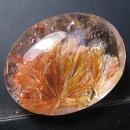|
|
||||||||||||||||
|
||||||||||||||||
|
||||||
|
|
|
|
Pyrophyllite
(inclusions
in Quartz) |
|
| | |
| Discovered in 1829; IMA status: Valid (pre-IMA; Grandfathered) | ||
|
| ||
|
Chemistry |
|
|
| |
|
Al2SiO4O10(OH)2 | |
|
|
Aluminum Silicate Hydroxide |
|
Molecular Weight: |
360.31 gm |
|
Composition: |
Aluminum |
14.98 % |
Al |
28.30 % |
Al2O3 |
|
|
Silicon |
31.18 % |
Si |
66.70 % |
SiO2 |
|
|
Hydrogen |
0.56 % |
H |
5.00 % |
H2O |
|
|
Oxygen |
53.28 % |
O |
|
|
|
|
|
100.00 % |
|
100.00 % |
= TOTAL OXIDE |
|
|
|
||||
|
Classification |
|
|
| |
|
Silicates (Germanates) | |
|
8/H.09-10 | |
|
|
9 : SILICATES (Germanates)
|
|
Related to: |
Pyrophyllite-Talc Group. Polymorphism: 2M1; 1A polytypes. |
|
Members of Group: |
Pyrophyllite-Talc Group: Ferripyrophyllite, Minnesotaite, Pyrophyllite, Talc, Willemseite |
|
Varieties: |
Cattle Egg Stone, Chrome-Pyrophyllite, Gelpyrophyllite |
|
Synonyms: |
Ablikite |
|
|
|
|
Crystal Data |
|
|
|
|
|
Monoclinic
- Prismatic
or Triclinic - Pinacoidal
|
|
|
As lamellar crystals, to 8 cm; in compact spherulitic aggregates of needlelike radiating crystals; as fine grained foliated laminae, granular, massive. |
|
|
None |
|
|
|
|
|
Physical Properties |
|
|
|
|
|
Perfect on {001} |
|
|
Flexible |
|
|
Flexible but inelastic |
|
|
1.0 - 2.0 |
|
|
2.65 - 2.90 (g/cm3) |
|
|
None |
|
|
Not Radioactive |
|
|
|
|
|
Optical Properties |
|
|
|
|
|
White, pale blue, yellow, apple-green, grayish green, brownish green; colorless in thin section |
|
|
Translucent to opaque |
|
|
Pearly to dull |
|
|
1.534 - 1.601 Biaxial ( - ) |
|
|
0.062 |
|
|
Weak; r > v |
|
|
n/a |
|
|
|
|
|
Occurances |
|
|
|
|
|
Geological Setting: |
Somewhat uncommon, found both in hydrothermal veins and in bedded deposits in schistose metamorphic rocks. |
|
Common Associations: |
Kyanite, Andalusite, Topaz, Mica, Quartz |
|
Common Impurities: |
n/a |
|
First Recorded Locality: |
Pyshminskoe deposit (Staro-Pyshminskoye), Berezovskoe Au Deposit (Berezovsk Mines), Berezovskii (Berezovskii Zavod), Ekaterinburg (Sverdlovsk), Sverdlovskaya Oblast', Middle Urals, Urals Region, Russia |
|
Year Discovered: |
1829 |
|
View mineral photos: | |
|
|
|
|
More Information |
|
|
|
|
|
| |
|
|
|
|
Pyrophyllite is available as interesting and attractive mineral speciments but never as faceted gems. However, it is available rarely as radiating spray inclusions with pearly luster in clear Quartz cabochons (as pictured above). The main source of these beautiful inclusion cabochons is Minas Gerais, Brazil. Distribution:
Some localities for rich or well-crystallized material
follow. In Russia, at Krassik, between Pyschminsk and
Beresov, Ural Mountains. From St. Niklas, Zermatt, Valais,
Switzerland. In Sweden, at Västanå, Kristianstad.
From near Ottré, Ardennes Mountains, Belgium.
In the USA, found near Ogilby, Imperial County, at Tres
Cerritos, Mariposa County, and the Champion mine, White
Mountains, Mono County, California; from near Quartzsite,
La Paz County, Arizona; at Staley, Randolph County,
Glendon and Robbins, Moore County, and Hillsborough,
Orange County, North Carolina; in the Brewer mine, Chesterfield
County, South Carolina; on Graves Mountain, Lincoln
County, Georgia. From Ibitiara, Bahia, Brazil, in large
crystals. In a number of mines in Nagano Prefecture,
and elsewhere in Japan. |
|
|
We
have not photographed our Pyrophyllite
gems yet. Please
check back soon. |
